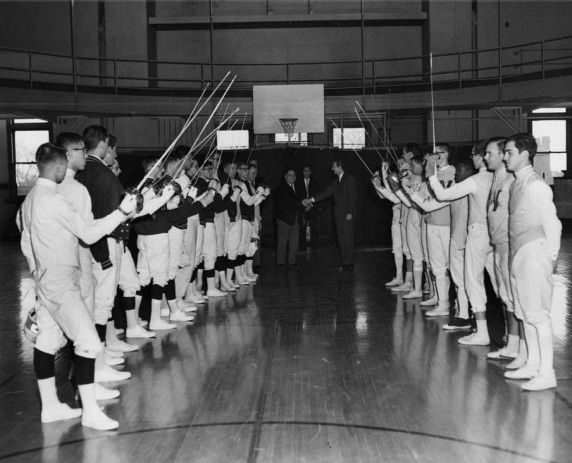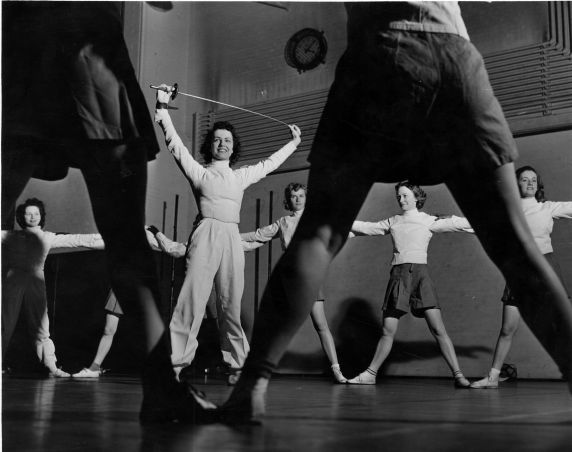The Wayne State University Fencing Program
In the Winter 2013 semester, the Reuther Library worked with students in the Graduate Certificate in Archival Administration program at the Wayne State School of Library and Information Science to produce a series of student-written, guest blog posts.
Maria Lourenço de Deus is an Archival Science undergraduate student from Federal University of Minas Gerais, in Brazil. She is taking classes at the School of Library and Information Science as an exchange student for the 2013 Winter semester.
“In succeeding so well in so demanding a sport, the Tartars have not only earned the respect and admiration of their school and their community, they have also become a source of pride for our entire state.” (The South End, May 1979)
There is no way we can talk about Wayne State University Athletics without mentioning the role that the Fencing Program played in its history. Officially established at WSU – at that time, Wayne University – in the 1938-1939 season, the team was under command of Ted Kaczander, followed by Joseph Savich the next year. Both of them were head coaches for only a year, their successor being Bela de Tuscan, who led the men’s team to its first significant records in the NCAA. In the Wayne State University Archives, we can find the first references to the Fencing Program in the mid 1930s, when beginner fencing classes were first offered. The men’s varsity team officially started in 1939, while it took women 34 years to have their debut, in 1973. The practice of fencing cultivated – and still does – a graceful carriage and promoted agility and muscular control. For this reason, many of the “weaker sex” were anxious to enroll in Mr. de Tuscan’s class when it made a minor part of the curriculum of the women’s athletic department in 1934. It soon became so popular that it spread to the men’s athletic department.
By that time, when the sport of fencing was discussed anywhere in the Midwest, the chances were good that sometime during the conversation the name of Bela de Tuscan would be mentioned. Better known as “Mr. Fencing,” de Tuscan was a former Hungarian World Sabre Fencer Champion (1919). He also perfected and held the patent for all electrical fencing equipment in the USA. These devices would illuminate fencing foils when a valid touch was made, modernizing the age-old sport to the extent that it can rival in spectators' appeal. His first meaningful results came in the late 1940s, particularly in 1949, the year in which winning seasons came to be a habit. At this point, the Fencing team schedules included matches with three Big Ten schools (Michigan State, Illinois, and Northwestern), as well as contests with Toronto University, Chicago University and the University of Detroit. Many Wayne fencers were letter-winners as well, in all 3 categories of the sport: foil, sabre, and épée.
When it comes to the first years of the Fencing Program, we can’t forget Byron Kreiger, foil fencer who first won an NCAA Championship in 1942. From the 1950s on, the men’s team became more present in the national championships, facing more tough opponents each day, such as Notre Dame, Illinois, Michigan State, Wisconsin, Ohio State, Detroit, Fenn College, Oberlin, and Cincinnati. Bruce Davis was definitely one of the most important fencers of this decade, bringing home two NCAA Championships in 1957 and 1958.
The 1950s also meant some hard times for the team. The lack of experienced fencers resulted in a bad season in 1951, when, for the first time since 1939, the Tartars failed to finish above the .500 mark, with only four victories in nine meetings. With de Tuscan’s retirement after 15 years at Wayne University, his friend Istvan Danosi took charge of the Fencing Program in 1957.
In Danosi’s first seven years at the helm, the WSU team ranked in the top 10 nationally every year and boasted winning seasons each time. Some important records of the 1960s are the 4th place NCAA finish in 1960 and the perfect 14-0 record season in 1961. “Maestro” Danosi took Wayne to 13 Top 10 NCAA finishes in his tenure, including 3rd place rankings in 1966 and 1974. The much-honored Tartar mentor put together a dual meet mark in 18 years with 17 winning seasons including the last 10 in a row, according to the 1976 Winter Sports Brochure. Furthermore, records show many victories in the PAC Fencing Championship and the Great Lakes Fencing Tournament. All these accomplishments helped the young fencers make it to the US Junior Olympic Championship. Highlighting some important names from this time: Bela Szentivanyi, Steve Danosi, Greg Benko, Yuri Rabinovich, and Ernest Simon.
WSU placed 1st at the NCAA four times in Danosi’s era (1975, 1979, 1980, 1982). After 25 years, with Danosi’s retirement, Aladar Kogler coached the team one year, in which WSU was also 1st place at NCAA, until Gil Pezza assumed the task. As a former WSU fencer and now coach, Pezza led the team for 6 seasons, with 2 NCAA Championships (1984 and 1985). In 1992, Jerdy Radz took charge of the team, until the present day. In these years, WSU produced more than 50 All Americans and was considered the finest program in the country.
When it comes to women, they started taking classes in de Tuscan’s era. Although, there was no women’s team and they were restricted to the use of foil only. Wayne’s first intercollegiate women's fencing team made its debut in 1973. The team was first coached by volunteer student coach Zoltan Csete, until Danosi took charge of it. They won the NCAA Championship 4 times (1975, 1982, 1988, 1989). Some of the most important fencers were Gina Farkashazy, Joyce Latrigue, Judy Wstrick, Mary Krause and Kathy Watson.
In the 1980s, Wayne State University was facing a severe budget crisis. In an attempt to save money, the university considered cutting athletic programs like baseball, basketball, football, track, and tennis. However, according to vertical file clippings, WSU needed to have 6 NCAA sports to continue competing in Fencing, so they decided not to cut other programs, illustrating the importance of the Fencing Program to Wayne State.
In total, Wayne State had 27 individual national champions until the present season, third most of any school. Two WSU fencers (Greg Benko and Ernest Simon) are tied for second in NCAA history with three career individual. In the Wayne University Athletics Collection, there are plenty of reports about the team’s accomplishments through the years. Other great resources on this topic are the vertical file of sports clippings, the Wayne State University University Relations Division Records, Wayne State University Health and Physical Education Division Records, Wayne State University Yearbook Collection, and the Wayne State Student Newspapers.
- Public Relations Team's blog
- Login to post comments
- Printer-friendly version



 Reddit
Reddit Facebook
Facebook LinkedIn
LinkedIn